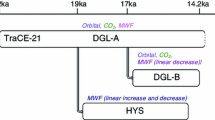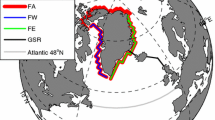Abstract
The overshoot phenomenon of the Atlantic thermohaline circulation (THC) is a transient climate response to meltwater forcing and could induce intense climate change by increasing the magnitudes of Atlantic THC changes at the end of meltwater discharges. This phenomenon was formally presented with the successfully simulated Bølling–Allerød (BA) event in the first transient simulation of the last deglaciation with fully coupled model NCAR-CCSM3 (TraCE-21K). Currently, not all proxy records of Atlantic THC support the occurrence of the THC overshoot at BA. Commonly used THC proxy from Bermuda Rise (GGC5) does not exhibit THC overshoot at BA but other proxies such as TTR-451 at Eirik Drift do. How to interpret this regional discrepancy of proxy records is a key question for the validation of the Atlantic THC overshoot at BA. Here, we show that the vigor of deep circulation varies regionally during the Atlantic THC overshoot at BA in TraCE-21K simulation, and this regional discrepancy in the simulation is consistent with that in the marine sediment records in North Atlantic. The consistent model–proxy evidence supports the occurrence of Atlantic THC overshoot at BA.






Similar content being viewed by others
References
Stouffer RJ, Yin J, Gregory JM et al (2006) Investigating the causes of the response of the thermohaline circulation to past and future climate changes. J Clim 19:1365–1387
Liu Z, Otto-Bliesner BL, He F et al (2009) Transient simulation of last deglaciation with a new mechanism for Bølling–Allerød warming. Science 325:310–314
Cuffey KM, Clow GD (1997) Temperature, accumulation and ice sheet elevation in central Greenland through the last deglacial transition. J Geophys Res 102:26383–26396
McManus JF, Francois R, Gherardi JM et al (2004) Collapse and rapid resumption of Atlantic meridional circulation linked to deglaciation climate changes. Nature 428:834–837
Stanford JD, Rohling EJ, Hunter SH et al (2006) Timing of meltwater pulse 1a and climate responses to meltwater injections. Paleoceanography 21:PA4103
Renold M, Raible CC, Yoshimori M et al (2009) Simulated resumption of the North Atlantic meridional overturning circulation. Quat Sci Rev 29:101–112
Barker S, Knorr G, Vautravers MJ et al (2010) Extreme deepening of the Atlantic overturning circulation during deglaciation. Nat Geosci 3:567–571
Yeager SG, Shields CA, Large WG et al (2006) The low-resolution CCSM3. J Clim 20:2545–2566
Siddall M, Stocker TF, Henderson GM et al (2007) Modeling the relationship between 231Pa/230Th distribution in North Atlantic sediment and Atlantic meridional overturning circulation. Paleoceanography 22:PA2214
Keigwin LD, Boyle EA (2008) Did North Atlantic overturning halt 17000 years ago? Paleoceanography 23:PA1101
Lippold J, Grützner Christl M, Winter D et al (2009) Does sedimentary 231Pa/230Th from the Bermuda Rise monitor past Atlantic meridional overturning circulation? Geophys Res Lett 36:L12601
Anderson R, Bacon M, Brewer P (1983) Removal of 230Th and 231Pa from the open ocean. Earth Planet Sci Lett 62:7–23
Chase Z, Anderson R, Fleisher M et al (2002) The influence of particle composition and particle flux on scavenging of Th, Pa and Be in the ocean. Earth Planet Sci Lett 204:215–229
Kretschmer S, Geibert W, Schnabel C et al (2008) Distribution of 230Th, 10Be and 231Pa in sediment particle classes. Geochim Cosmachim Acta 72:A498
Gherardi J-M, Labeyrie L, Nave S et al (2009) Glacial-interglacial circulation changes inferred from 231Pa/230Th sedimentary record in the North Atlantic region. Paleoceanography 24:PA2204
Scholten J, Fietzke J, Mangini A et al (2008) Advection and scavenging: effect on 230Th and 231Pa distribution off southwest-Africa. Earth Planet Sci Lett 271:159–169
Marchal O, Francois R, Stocker TF et al (2000) Ocean thermohaline circulation and sedimentary 231Pa/230Th ratio. Paleoceanography 15:625–641
Kawase M (1987) Establishment of deep ocean circulation driven by deep-water production. J Phys Oceanogr 17:2294–2317
Johnson H, Marshall D (2004) Global teleconnections of meridional overturning circulation anomalies. J Phys Oceanogr 34:1702–1722
Bower AS, Lozier MS, Gary SF et al (2009) Interior pathways of the North Atlantic meridional overturning circulation. Nature 459:243–247
Pedlosky J (1984) Cross-gyre ventilation of the subtropical gyre: an internal mode in the ventilated thermocline. J Phys Oceanogr 14:1172–1178
Lynch-Stieglitz J, Adkins JF, Curry WB et al (2007) Atlantic meridional overturning circulation during the Last Glacial Maximum. Science 316:66–69
Griffies S, Tziperman EA (1995) Linear thermohaline oscillator driven by stochastic atmospheric forcing. J Clim 8:2440–2453
Mignot J, Ganopolski A, Levermann A (2007) Atlantic subsurface temperatures: response to a shutdown of the overturning circulation and consequences for its recovery. J Clim 20:4884–4898
Acknowledgments
The authors thank R. Anderson for a helpful discussion on the implication of 231Pa/230Th. This work was supported by National Natural Science Foundation of China (41206024, 41130105), the National Science Foundation and Department of Energy of USA. This paper is Earth System Modeling Center (ESMC) contribution number ESMC-007.
Conflict of interest
The authors declare that they have no conflict of interest.
Author information
Authors and Affiliations
Corresponding author
About this article
Cite this article
Cheng, J., Liu, Z., He, F. et al. Model–proxy comparison for overshoot phenomenon of Atlantic thermohaline circulation at Bølling–Allerød. Chin. Sci. Bull. 59, 4510–4515 (2014). https://doi.org/10.1007/s11434-014-0586-x
Received:
Accepted:
Published:
Issue Date:
DOI: https://doi.org/10.1007/s11434-014-0586-x




